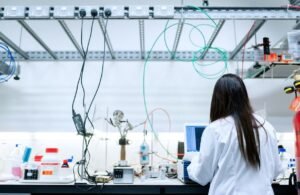AI Manufacturing Use Cases
Artificial Intelligence (AI) is revolutionizing various industries, and manufacturing is no exception. AI technology is being integrated into manufacturing processes to optimize operations, improve quality control, enhance productivity, and drive innovation. This article explores some of the key use cases of AI in the manufacturing sector.
Key Takeaways:
- AI is transforming manufacturing by optimizing operations, improving quality control, and enhancing productivity.
- Machine learning algorithms are enabling predictive maintenance to reduce downtime and improve equipment efficiency.
- Computer vision systems are improving quality control by detecting defects in real-time during production.
- AI-powered robotics are streamlining production lines, increasing efficiency, and reducing human error.
- Natural language processing (NLP) and chatbots are enhancing customer service and streamlining communication.
Predictive Maintenance using Machine Learning
One of the key use cases of AI in manufacturing is predictive maintenance using machine learning algorithms. By analyzing real-time data from sensors and equipment, AI algorithms can identify patterns and anomalies that indicate potential equipment failures. This proactive approach allows manufacturers to schedule maintenance before breakdowns occur, reducing downtime and improving equipment efficiency. *Predictive maintenance can save companies up to 12% over scheduled repairs, reduce overall maintenance costs by up to 30%, and eliminate breakdowns by up to 70%.*
Computer Vision for Quality Control
Computer vision systems equipped with AI algorithms can analyze images and videos captured during the production process to detect defects in real-time. These systems can identify visual anomalies, measure product dimensions, and compare against quality standards. *Computer vision improves quality control by reducing human error and ensuring consistent product quality, with defect detection rates reaching 99% accuracy.*
| Benefits | Statistics |
|---|---|
| Reduced downtime | Up to 30% reduction in downtime |
| Improved equipment efficiency | Up to 45% improvement in equipment efficiency |
| Cost savings | Up to 12% savings on maintenance costs |
Streamlining Production with AI-Powered Robotics
Robots equipped with AI capabilities are increasingly being used in manufacturing to automate tasks, streamline production lines, and increase efficiency. These robots can handle complex tasks with precision and consistency, reducing human error and improving overall speed and accuracy. *AI-powered robots can increase productivity by up to 50% and have a payback period as short as one year.*
Natural Language Processing and Chatbots for Communication
Natural Language Processing (NLP) technology enables machines to understand and process human language. In manufacturing, NLP is utilized to develop chatbots that can assist customers, provide real-time support, and streamline communication within the organization. These chatbots are programmed to understand and respond to customer queries, provide product information, and troubleshoot common issues. *Chatbots can reduce customer support costs by up to 30% and handle a large number of simultaneous inquiries.*
| Benefits | Statistics |
|---|---|
| Increased productivity | Up to 50% increase in productivity |
| Higher accuracy | 99.9% accuracy in repetitive tasks |
| Economic value | Payback period as short as 1 year |
Integrating AI for Innovation
Integrating AI into manufacturing processes opens up avenues for innovation. By leveraging machine learning algorithms, manufacturers can gain insights from vast amounts of data, optimize production workflows, and make data-driven decisions. AI can also assist in product design, optimizing supply chain management, and developing personalized products. *The integration of AI into manufacturing is driving innovation and enabling businesses to stay competitive in a rapidly changing market.*
In conclusion, AI is transforming the manufacturing sector by optimizing operations, improving quality control, enhancing productivity, and driving innovation. Predictive maintenance, computer vision for quality control, AI-powered robotics, and natural language processing with chatbots are just a few examples of how AI is being applied in manufacturing. As technology continues to advance, AI is expected to play an even more significant role in reshaping the industry.

Common Misconceptions
When it comes to AI in manufacturing, there are several common misconceptions that people tend to have. Let’s debunk some of these misconceptions:
Misconception #1: AI will replace human workers entirely
Contrary to popular belief, AI in manufacturing is not aimed at completely replacing human workers. Rather, it is meant to enhance their abilities and improve their efficiency.
- AI systems can automate repetitive and labor-intensive tasks, freeing up human workers to focus on more complex and creative tasks.
- The collaboration of AI and human workers can lead to increased productivity and better quality control.
- Human workers are still crucial for decision-making, problem-solving, and adapting to unpredictable circumstances.
Misconception #2: AI manufacturing systems are too expensive and complex to implement
While implementing AI systems in manufacturing may require an initial investment, they can provide significant long-term benefits that make them worthwhile.
- The cost of AI technologies, such as machine learning algorithms and robotics, has reduced over time making them more accessible to manufacturers.
- AI systems can streamline production processes, reduce errors, and minimize downtime, resulting in cost savings in the long run.
- Many companies offer user-friendly AI solutions specifically designed for manufacturing, making implementation less complex than perceived.
Misconception #3: AI will lead to job losses in the manufacturing industry
One common fear is that AI implementation in manufacturing will lead to a significant decrease in job opportunities. However, the reality is quite different.
- While some job roles may change or become obsolete, new roles will emerge to support and manage AI systems.
- AI can enhance worker productivity and create new job opportunities in areas such as AI system maintenance, data analysis, and AI project management.
- By automating repetitive tasks, AI can help manufacturers scale up, leading to potential business growth, and subsequently, job creation.

Impact of AI on Customer Service
In today’s digital era, customer service plays a crucial role in the success of any business. AI has revolutionized the customer service industry, offering more personalized and efficient experiences. This table highlights some of the key use cases of AI in customer service.
| Use Case | Description | Benefits |
|---|---|---|
| Chatbots | AI-powered chatbots provide instant responses to customer queries, reducing wait times and improving customer satisfaction. | 24/7 availability, quick issue resolution, cost-effective |
| Virtual Assistants | AI-powered virtual assistants offer personalized support, assisting customers with product recommendations, order tracking, and more. | Enhanced customer engagement, time-saving |
| Sentiment Analysis | AI analyzes customer feedback and sentiments, allowing companies to identify and address concerns more effectively. | Improved customer experience, better brand reputation management |
| Predictive Analytics | AI algorithms analyze customer data to predict future behavior, aiding in targeted marketing and personalized offers. | Increased sales, improved customer retention |
Enhancing Supply Chain Efficiency
Efficient supply chain management is crucial for manufacturers to meet customer demands in an increasingly competitive market. AI-powered solutions offer new possibilities for optimizing supply chain operations. This table presents a few notable use cases of AI in enhancing supply chain efficiency.
| Use Case | Description | Benefits |
|---|---|---|
| Inventory Management | AI algorithms analyze historical data and demand patterns to optimize inventory levels, reducing wastage and stockouts. | Cost reduction, improved order fulfillment |
| Route Optimization | AI algorithms optimize the delivery routes considering multiple factors like traffic, weather, and order priorities. | Reduced transportation costs, faster deliveries |
| Supply Chain Visibility | AI-powered analytics provide real-time visibility into the supply chain, enabling proactive issue identification and resolution. | Improved decision-making, reduced disruptions |
| Demand Forecasting | AI models analyze customer data and market trends to accurately predict demand, enabling better production planning. | Optimized inventory, reduced stockouts, enhanced customer satisfaction |
Quality Assurance through AI
Ensuring product quality and minimizing defects are critical for manufacturing companies. AI technologies provide innovative solutions that enhance quality assurance processes. This table highlights some AI use cases in quality assurance.
| Use Case | Description | Benefits |
|---|---|---|
| Visual Inspection | AI-powered vision systems analyze product images to identify defects and anomalies with greater accuracy and speed. | Reduced manufacturing defects, increased productivity |
| Predictive Maintenance | AI algorithms analyze sensor data and machine learning models to predict equipment failures and schedule maintenance proactively. | Preventive maintenance, minimized downtime |
| Process Optimization | AI-based process monitoring and optimization systems continuously analyze data to identify process inefficiencies and suggest improvements. | Increased productivity, reduced waste |
| Root Cause Analysis | AI tools help identify root causes of quality issues by analyzing vast amounts of production data, enabling targeted improvements. | Improved product quality, faster problem-solving |
AI and Human Resources
AI has transformed various aspects of human resource management, enabling HR professionals to streamline processes and make data-driven decisions. This table presents key use cases of AI in the HR domain.
| Use Case | Description | Benefits |
|---|---|---|
| Talent Acquisition | AI-powered systems automate candidate screening, resume parsing, and job matching, enabling efficient recruitment processes. | Faster hiring, improved candidate quality |
| Employee Engagement | AI-driven tools offer personalized feedback, recognition, and learning recommendations to enhance employee satisfaction and engagement. | Increased motivation, improved retention |
| Performance Management | AI-enabled performance management systems provide objective evaluation metrics and identify areas for employee development. | Fair performance assessments, targeted development |
| Sentiment Analysis | AI analyzes employee sentiments through surveys or social media, helping HR teams monitor employee well-being and take appropriate actions. | Improved employee satisfaction, reduced turnover |
Optimizing Product Design with AI
A key challenge for manufacturers is designing products that meet customer needs while optimizing costs. AI technologies provide valuable insights for product design and iteration. This table presents some AI use cases for optimizing product design.
| Use Case | Description | Benefits |
|---|---|---|
| Generative Design | AI algorithms generate multiple design alternatives based on predefined constraints, enabling efficient exploration of innovative solutions. | Reduced design time, improved creativity |
| Simulation and Testing | AI-powered simulations evaluate product performance and behavior, reducing the need for physical prototypes and speeding up development. | Cost savings, faster time to market |
| Design Data Analysis | AI analyzes design data, customer feedback, and market trends to identify improvement opportunities and inform design refinements. | Enhanced product usability, better customer satisfaction |
| Material Selection | AI algorithms evaluate material properties and performance requirements to suggest optimal materials for specific product applications. | Improved durability, cost optimization |
Automating Production Processes with AI
Manufacturers are increasingly leveraging AI technologies to automate and optimize various production processes. This table highlights some important use cases of AI in production automation.
| Use Case | Description | Benefits |
|---|---|---|
| Robotic Process Automation | AI-powered robots automate repetitive and manual tasks on the production line, increasing efficiency and reducing human error. | Increased productivity, improved accuracy |
| Predictive Maintenance | AI algorithms predict equipment failures to schedule maintenance and minimize production downtime. | Reduced maintenance costs, minimized disruptions |
| Quality Control | AI-based vision systems inspect product quality during manufacturing to ensure compliance with standards and specifications. | Reduced defects, improved product quality |
| Process Optimization | AI models continuously analyze production data to identify process bottlenecks and suggest optimization measures for increased efficiency. | Reduced waste, improved resource utilization |
AI Revolutionizing Maintenance and Field Services
Maintenance and field services are crucial functions for manufacturers to maximize uptime, minimize costs, and deliver superior customer service. This table highlights some of the key AI use cases in maintenance and field services.
| Use Case | Description | Benefits |
|---|---|---|
| Predictive Maintenance | AI algorithms predict equipment failures by analyzing real-time sensor data, enabling proactive maintenance to prevent breakdowns. | Reduced downtime, decreased maintenance costs |
| Remote Monitoring | AI-powered IoT sensors monitor equipment performance remotely and generate real-time alerts for timely preventive measures. | Improved equipment uptime, reduced on-site visits |
| Schedule Optimization | AI-based scheduling systems optimize technician schedules, considering factors like availability, skill set, and travel time to maximize efficiency. | Reduced travel time, improved resource utilization |
| Knowledge Management | AI-powered knowledge bases store and retrieve maintenance information, providing technicians with quick access to troubleshooting guides and solutions. | Faster problem-solving, improved service quality |
Safety Enhancement with AI
Ensuring safety in manufacturing environments is of utmost importance. AI technologies offer valuable solutions to enhance safety measures and minimize accidents. This table presents some AI use cases in manufacturing safety.
| Use Case | Description | Benefits |
|---|---|---|
| Computer Vision | AI-powered computer vision systems monitor the shop floor for potential safety hazards and provide real-time alerts. | Improved accident prevention, enhanced worker safety |
| Worker Behavior Analysis | AI algorithms analyze worker behavior to detect unsafe practices, allowing intervention and training for safer working conditions. | Reduced accident rates, improved safety culture |
| Predictive Analytics | AI models analyze historical safety data to predict and prevent accidents, enabling proactive safety measures. | Enhanced risk assessment, minimized accidents |
| Smart Personal Protective Equipment | AI embedded in personal protective equipment enhances safety through sensors, real-time monitoring, and alerts for workers. | Improved worker protection, reduced injuries |
AI Enhancing Productivity and Workforce Management
AI technologies offer innovative solutions to enhance productivity and optimize workforce management in manufacturing organizations. This table highlights some key use cases of AI in productivity and workforce management.
| Use Case | Description | Benefits |
|---|---|---|
| Workforce Planning | AI models analyze historical data and demand forecasts to optimize staffing levels, ensuring adequate resources at all times. | Optimized workforce management, reduced labor costs |
| Task Automation | AI automates repetitive and mundane tasks, enabling employees to focus on higher-value work and increasing overall productivity. | Time savings, increased efficiency |
| Performance Analytics | AI-powered analytics provide real-time insights into employee performance, enabling targeted feedback and continuous improvement. | Objective performance evaluations, improved productivity |
| Workplace Safety | AI technologies monitor the workplace environment for hazards, ensuring compliance with safety regulations and preventing accidents. | Enhanced safety culture, reduced liabilities |
From revolutionizing customer service and supply chain management to improving product design, quality assurance, and maintenance processes, AI is transforming the manufacturing industry. By leveraging AI technologies and analyzing vast amounts of data, manufacturers can optimize operations, reduce costs, enhance product quality, and deliver better customer experiences. As AI continues to evolve and integrate with manufacturing processes, its role in driving innovation and efficiency will be even more significant.
Frequently Asked Questions
1. What are some common use cases for AI in manufacturing?
There are several common use cases for AI in manufacturing, including predictive maintenance, quality control, demand forecasting, supply chain optimization, and autonomous robots in assembly lines.
2. How does predictive maintenance using AI work in manufacturing?
Predictive maintenance using AI involves analyzing sensor data from machines to detect patterns and anomalies that could indicate potential failures. By identifying maintenance needs in advance, manufacturers can reduce downtime and minimize equipment breakdowns.
3. How does AI improve quality control in manufacturing?
AI can enhance quality control by analyzing product data and images to identify defects or anomalies that may go unnoticed by human operators. AI systems can automatically flag and reject defective products, ensuring consistent quality standards.
4. How can AI assist in demand forecasting for manufacturers?
AI algorithms can analyze historical sales data, market trends, and other variables to provide accurate demand forecasts. Manufacturers can leverage this information to optimize production levels, reduce inventory costs, and ensure they meet customer demand.
5. How does AI optimize supply chain management in manufacturing?
AI can optimize supply chain management by analyzing data from various sources, such as inventory levels, production capacity, and customer demand. By predicting demand fluctuations, AI can streamline inventory management, optimize procurement processes, and reduce costs.
6. What are the benefits of using autonomous robots in manufacturing?
Autonomous robots can perform repetitive tasks with high precision and speed, reducing the need for manual labor. They can improve manufacturing efficiency, minimize errors, and enhance worker safety by taking over hazardous or physically challenging tasks.
7. How can AI enhance product design and development in manufacturing?
AI can assist in product design and development by generating and analyzing vast amounts of data, enabling rapid prototyping, and optimizing designs for cost and performance. It can also simulate product behavior and identify potential improvements before physical manufacturing.
8. Can AI be used to optimize energy consumption in manufacturing?
Absolutely. AI can analyze energy usage patterns, identify energy-saving opportunities, and suggest adjustments to equipment settings or manufacturing processes that minimize energy consumption. This can lead to significant cost savings and reduced environmental impact.
9. Are there any challenges in implementing AI in the manufacturing industry?
Yes, there are challenges in implementing AI in manufacturing, including the need for robust data collection and analysis infrastructure, cybersecurity concerns, workforce upskilling, and the need for integrating AI systems with existing manufacturing processes and technologies.
10. How can manufacturers get started with AI implementation?
To get started with AI implementation, manufacturers can begin by identifying areas in their operations where AI can bring significant value. They should assess their data availability and quality, evaluate AI solutions and vendors, and develop a well-thought-out implementation plan, considering both technical and organizational aspects.




